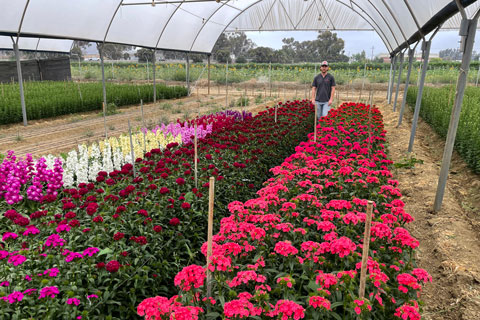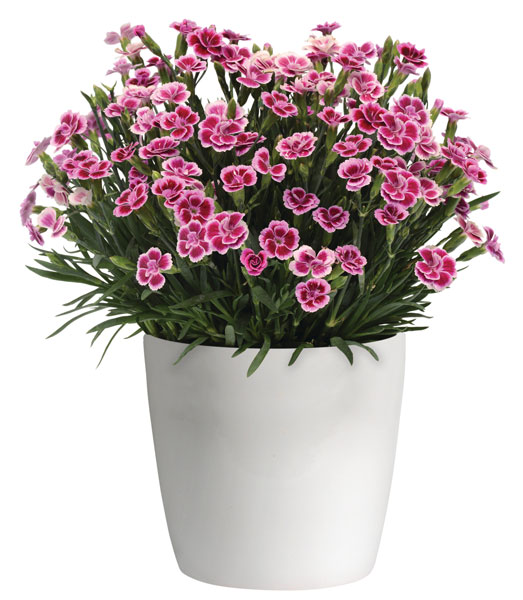11/1/2022
Dianthus Explained, Part 1
Reid Snyder & Gary Vollmer

Dianthus is everywhere these days! What was once known mostly by names like pinks, Sweet William and carnation as cool-season perennials, biennials or cut flowers has evolved into one of the most versatile plants in the horticulture world.
Pictured: The Amazon series of cut flower dianthus is known for its high yield of long, sturdy stems and bright, bold colors with few disease issues.
Over the past two decades, breeders around the globe have been working tirelessly to bring innovation to this unique and storied plant. By tapping into the great wealth of species and diversity in the dianthus world, new breakthroughs have been giving the dianthus a whole new role in the marketplace. These innovations can be classified into four main categories of dianthus in the market today: annuals, perennials, cut flowers, and potted/gift plants. One of the big challenges now is to understand what these dianthus are, what their best application is and when to use them.
Annuals
Dianthus has been widely used as an annual for both container and landscape use. The four most common types that you’ll encounter can be broken down by their different species background.
Dianthus barbatus—These Sweet Williams were traditionally biennials that required vernalization to flower, however, modern breeding has removed the need for vernalization. There are specific series for annual use and for cut flower use. The Dash series, for example, has been bred for annual use and is great for larger containers sizes like 6-in. up to a gallon and can also be used in the landscape. They do prefer cooler seasons, and like most annual dianthus, they’re primarily seed-raised.
Dianthus chinensis—Another great cool season performer that provides the largest flowers in the entire annual dianthus realm. They’re known for having beautiful rich colors, including stunning bicolors and patterns. These are best for 4- to 8-in. pots, color bowls, cool-season combos and seasonal landscape installations.
Dianthus chinensis x barbatus—One of the original interspecific dianthus crosses on the market, it uses one parent that’s Dianthus barbatus and one that’s Dianthus chinensis, creating a hybrid of the two species. Known for its earliness in flower and bright, medium-sized flowers, it’s great for cool-season, small pack and pot programs, and can also be used in seasonal landscape installations.
More recent to the market are Dianthus barbatus interspecific crosses. This unique genetic background has brought big innovation with heat tolerance and true summer performance. Great as an annual in quarts up to gallons, as a combo planter item and an excellent landscape performance with few disease issues. The market leader in this type is the Jolt series.
Perennials
Traditionally perennial dianthus have been Dianthus gratianopolitanus and Dianthus deltoides. There are still some of these straight species varieties in production, but most of the modern perennial varieties are interspecific in nature. By incorporating Dianthus caryophyllus, the interspecific breeding has brought a diversity of flower forms and colors, as well as first year and more continuous blooming.
Selecta’s series Everlast is an example of this new interspecific group. It brings a collection of single and double flowers, and a wide range of colors from white to deep reds with many multi-colored types as well. While maintaining its true perennial characteristic, a dramatic increase in season-long flowering and the addition of double flowers to this has significantly increased dianthus’ role in perennial programs.
 Pictured: Sweet William cut flower dianthus in trials. (That’s one of this article’s authors, Reid Snyder, in the background.)
Pictured: Sweet William cut flower dianthus in trials. (That’s one of this article’s authors, Reid Snyder, in the background.)
A wide diversity of plant types are now available in the true perennial category, including the traditional upright mounded gratianopolitanus types, traditional compact, mounding deltoides types and even series of double-flowered caryophyllus types like Selecta’s Carmen series.
Perennial dianthus are benefitted by their low energy requirements, low disease and insect pressure, and its superior shippability and shelf life. Perennial dianthus will continue to expand its role in the perennial world.
Cut flowers
Like with other categories of dianthus, cut flowers can be broken down into three common types based on their species. The most common and probably most traditionally known cut flower dianthus is the carnation.
Most modern carnations on the market are many evolutions from what we once knew. These are from the Dianthus caryophyllus species, and they’ve been bred and selected specifically for their use as cut flowers. They’re all highly productive, have an excellent vase life and many now have resistance to Fusarium. Most cut flower carnations on the market are produced from vegetative cuttings.
Another commonly used dianthus for cut flowers are Sweet William, Dianthus barbatus. Just like with the annual types, there are specific series and varieties bred for cut flower use. Modern breeding has eliminated the need for vernalization, so they’re much easier to program and produce to target important floral holidays. Cut flower Sweet William have been bred to have long, sturdy stems with minimal side branching. There are offerings from both seed and vegetative sources for Dianthus barbatus cut flowers.
There’s also a lot of interspecific development in the cut flower space as well. One of the more common crosses you’ll encounter is the Dianthus barbatus interspecific—again, just like with annuals, there are varieties and series bred specifically for cut flower use. The market-leading series for this type is Amazon, and it’s known for its high yield of long, sturdy stems and bright, bold colors with few disease issues. Amazon also tolerates a large range of temperatures and can be grown in mild to hot climates. Amazon is a seed-raised product.
Potted plants
The potted plant/premium annual category is the largest and fastest-growing area of dianthus sales. In Europe, this market has exploded, with demand in the hundreds of millions of units annually. This market is just beginning to develop in North America.
Historically, the pot carnation market was made up of varieties that were Dianthus caryophyllus. Like with other categories, the incorporation of interspecific breeding has brought a vast diversity of new types in this arena. There are very compact, early-flowering types that are ideal for Valentine’s Day, like the variety I Love U and the hyper uniform sport-based series Oscar.
 Pictured: Below: Pink Kisses is an example of a new interspecific potted type of dianthus. It has exceptional grower performance and consumer life. It also can be planted outside, as it will continuously bloom and perennialize.
Pictured: Below: Pink Kisses is an example of a new interspecific potted type of dianthus. It has exceptional grower performance and consumer life. It also can be planted outside, as it will continuously bloom and perennialize.
There are medium-vigor series targeting 4-in. pots up to 2.5-qt. pots. There are large patio plant types that will function as a large potted plant, as well as a source for backyard cut flowers. As with all the other dianthus types, these offer low-energy, low-insect and disease production, and can hold up through a diversity of shipping methods, including through produce systems, and both indoor and outdoor retail displays.
The high level of plant quality and performance available in today’s modern dianthus breeding provides opportunities for any grower for any season. With their ability to be grown counter season and with little or no energy input, they become the ideal genus for capturing early season market windows in all categories.
By offering both fragrant flowering plants for the garden, potted plants and cut flowers, dianthus are a great opportunity to add sales in both the garden center and indoor floral areas. With the ability to hit all spring holidays, and a product that can survive through many delivery and retail conditions, dianthus brings great solutions to growers and retailers alike.
If you’re currently growing some dianthus, try more of the newer genetics available and explore the opportunities that they can create. If you’re not growing dianthus, now is the perfect time to start. GT
Reid Snyder is a Product Development Manager for PanAmerican Seed and Gary Vollmer is Product & Technical Manager for Selecta North America.